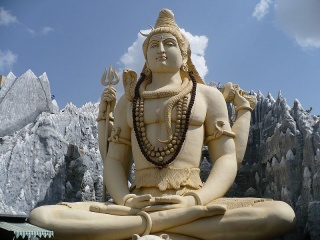Shiva: Difference between revisions
Jump to navigation
Jump to search
Pablo Sender (talk | contribs) (Redirected page to Śiva) |
No edit summary |
||
| (One intermediate revision by one other user not shown) | |||
| Line 1: | Line 1: | ||
[[File:800px-Bangalore_Shiva.jpg|right|320x240px]] | |||
'''Śiva''' (devanāgarī: शिव) is a [[Sanskrit]] word meaning "auspicious one" is a major [[Hinduism|Hindu]] deity, part of the [[Trimūrti]]. He is the destroyer of evil or transformer. Shiva is depicted as a yogi, living a life of a sage at Mount Kailash. In images, he is represented as immersed in deep meditation or dancing upon the demon of ignorance. He is usually worshipped in the abstract form of [[Liṅgam|Shiva linga]]. | |||
== Additional resources == | |||
* [https://www.theosophy.world/encyclopedia/siva-and-saivism Siva and Saivism] in Theosophy World | |||
== Notes == | |||
<references/> | |||
[[Category:Sanskrit terms]] | |||
[[Category:Hindu mythology]] | |||
[[Category:Hindu concepts]] | |||
Latest revision as of 03:43, 22 November 2023
Śiva (devanāgarī: शिव) is a Sanskrit word meaning "auspicious one" is a major Hindu deity, part of the Trimūrti. He is the destroyer of evil or transformer. Shiva is depicted as a yogi, living a life of a sage at Mount Kailash. In images, he is represented as immersed in deep meditation or dancing upon the demon of ignorance. He is usually worshipped in the abstract form of Shiva linga.
Additional resources
- Siva and Saivism in Theosophy World
